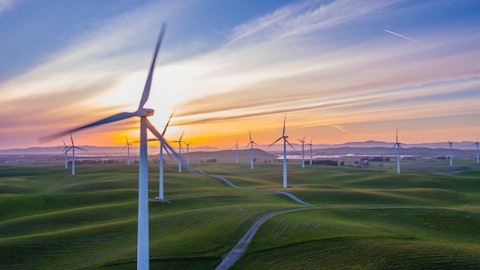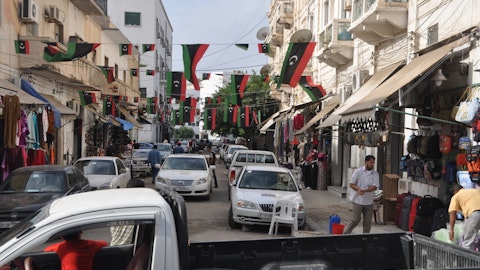This includes tax normalization to even out taxes across the third and fourth quarter and without that, the net debt ratio would have been around negative 30%. So, let us conclude with our guiding. As stated last quarter, we saw a higher downside risk to our production guidance. Due to the unplanned production losses in the third quarter, we adjust our guidance to around 1.5% production growth in 2023. Organic CapEx is so far this year $7.2 billion. We maintain or guiding of $10 billion to $11 billion for the year and we expect to be in the lower end of this range. We will, as usual, revert to longer-term CapEx guidance at our Capital Markets update in February. So, with that, I will hand it over back to you, Bard, and I do look forward to your questions.
So, thank you very much.
Bard Glad Pedersen : Thank you, Torgrim. And we are then ready to start the Q&A session. So, operator, if you can remind of the instructions for that?
Operator: [Operator Instructions].
Bard Glad Pedersen: Your first question comes from the line of Biraj Borkhataria from Royal Bank of Canada.
Biraj Borkhataria: I wanted to circle back on the U.S. wind position. So, you’ve taken the impairment today. Last night, there was some news from the New York State around a request for consultations. It seems like they’re making an effort to expedite some of these things and push these things forward. Where does this leave Equinor and Empire Wind? You obviously took the decision to impair because you couldn’t negotiate the PPA, but I’m just wondering what the next steps are from here? And then the second one is on Norwegian output. Arguably, you’ve had more than your fair share of unplanned outages this year. When you do some audits and analysis? Is there a common theme here in terms of the issues or all of these projects specific? And how can investors get some comfort around your ability to produce reliably going forward given the issues this year? Thank you.
Torgrim Reitan: Okay. Thank you very much, Biraj. So, on your first question on U.S. wind, yes. So, I mean, the repetition towards the state, it was rejected. And that was the basis for the impairments that we have done. And right after we received that rejection, the state came out with a 10-point action plan, for opportunities to rebid on our contracts. And then as you said last night, they came out with sort of, how they want to run this process, where they would like feedback from us next week on our process, and then we’ll see where that leads us. So, first of all, we clearly, we welcome, that they push forward the action plan quickly and what they are doing now. I do find that as a signal of commitment and a willingness to fast forward process.
For us, it’s too early to conclude. But what I want to say is that for us to move forward with these projects, we need to see profitability that is sort of reflecting the risk at hand. So, we will continue to work closely with the state as sort of the process unfold, and we will be more than happy to share more details when we know no more naturally. On your second question, on the Norwegian output. So, let me first go through the different sort of incidents or things that happened. We had Melkoya during the summer, with a gas leakage an incident that sort of halted production from Snohvit during summer and also into the third quarter. We had Nyhamna, which is a processing plant operated by Shell, where the turnaround was prolonged. And that sort of led to that we need to hold back production from Aasta Hansteen, which we operate, but also Ormen Lange operated by Shell needed to hold back production due to the prolonged, and turnaround Nyhamna.
And the third one is on Troll A, which was due to a turnaround, but as we were starting that up, we discovered some welding issues on some of the work, so we needed to revisit that, and that sort of delayed the startup of Troll with 13 days as such. My point is that these three events are not interconnected in any way. They are separate incidents, and all of these are plans of high integrity and high quality. And it’s not going to, I mean, we are confident that this will have no long-term impact as such. In general terms, I would say that the standard and quality of our facilities is very high and demonstrated by high production efficiency. I think on, when we talk about production output next year and the following year. Let me give you a couple of data points.
You have seen Breidablikk coming on stream recently. So that is sort of adding production next year. Also, Vito in the Gulf of Mexico, then Johan Castberg is sort of the big new start of next year. That is planned to come towards the end of 2024, so it will have a limited impact on the full year. But in the last quarter, we expect that to have a good impact. We are also a startup of Kristin South Phase 1 with some volumes as such. But please remember, there is an underlying decline in the portfolio that we need to be aware of well. And then in 2025, we have Bacalhau Phase 1 as a significant start-up. And also, there’s a lineup of NCS, assets that are coming with a good production, and output as such. So, I mean, it’s a solid portfolio with profitable assets coming on board and what we have seen this year, we don’t see that having a long-term impact on the ability to produce.
So, thanks, Biraj.
Biraj Borkhataria: Thank you. Very much.
Bard Glad Pedersen: The next question will be Giacomo Romeo from Jefferies.
Giacomo Romeo: Yes. Thank you. First question I have is on Dogger Bank A. You announced first power in October, however, we noticed that only four turbines have been installed out of the 94 since the end of August. Just wondering when do you expect to reach full power capacity? That’s some clarity there if possible? Thank you. Just second question is, you had a good contribution in MMP from crude products and liquids again this quarter. Obviously, we normally talk about your gas and power trading business, but crude has and products have done very well and pretty decently. Is anything has changed here in the way you sort of look at the optimization in trade around liquids? Some color there would be great. Okay.
Torgrim Reitan: Thank you very much, Giacomo. So first on Dogger Bank. Yes, first power, very glad to see that. So, this is sort of being installed. There are many turbines, and we expect sort of full power. Next year, in third quarter, as such for Dogger Bank A. Really looking forward to that. And, Dogger Bank projects are looking good from a profitability perspective. In the UK, the contractual differences are adjusted for inflation, and with sort of the inflation seen in the UK over the last years, that has contributed well to do very attractive assets. On your second question on MMP, yes. So, I mean, MMP continues to deliver strongly and this quarter above the increased guidance that we gave at the Capital Markets Day. And I also think it’s worth noting that natural gas which was sort of the big contributors last year, it’s still contributing solidly, but they are not the one doing sort of the heavy lifting in this result.




